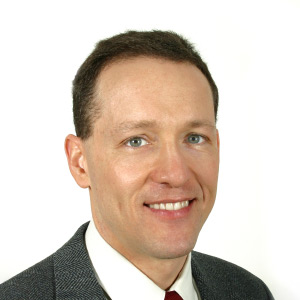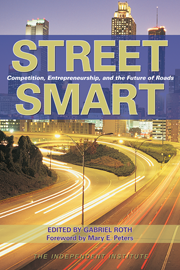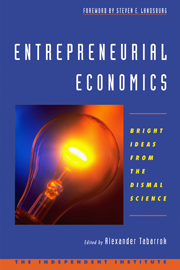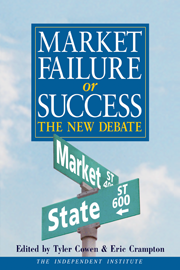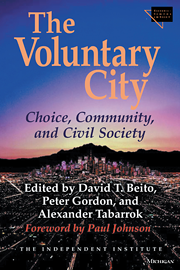When an economist stands at the blackboard and draws a supply-and-demand diagram, he pretends he knows all the relevant opportunities. Economists must posit such settings to frame the story. When stories are given an exact formulation, especially when expressed in math or diagrams, they are called “models.” A resolution in such a model is called “equilibrium.” Models teach us much about competition, investment, and many other important topics in economics. But overexposure to models can impair our ability to see other important facets of economic processes. One begins to forget that there is so much that is not known.
Focusing on blackboard models limits our understanding of economic freedom. Economists focus so much on models like supply and demand, rather than on public issues, that freedom is understood only for what it achieves in such models. Equilibrium stories of price ceilings, price floors, and entry barriers lead us to think of markets as neatly characterized procedures, and of freedom as little more than the freedom to choose within these procedures. It may be the freedom of tenants to choose high-rent apartments, of laborers to choose low-wage employment, or of consumers to choose the services of unlicensed electricians. Because equilibrium stories posit the industry, the preferences, and the opportunities, all that freedom accomplishes is a more efficient utilization of given resources.
Economists rarely talk of discovery, imagination, or serendipity, and consequently they tend to neglect these as vital factors of economic progress. They often carry over their habits of mind to public policy. In consequence, they are insensible to the fact that government restrictions on freedom tend to choke off the vital discovery factors.
For example, the economist might think that in making policy for urban transit, government experts can, after much careful study, adequately determine the transit technologies and systems that would suit the city’s needs, and then implement the system. I would dispute that approach, regardless of the particular transit system proposed. We shall return to the example of urban transit throughout this essay.
Freedom to choose among a set of given alternatives is but one facet of freedom. I will discuss three other facets of freedom. Each of them points to a kind of discovery.
Search and Respondence
As consumers we do not know fully what stores are offering or what prices they are charging. We need to gain information and do so by searching. Searching takes time and trouble, but we learn more about the available alternatives.
In other cases, information simply comes to us without our looking for it. Perhaps by chance we encounter advertisements that alert us to valuable opportunities. Perhaps we get into a conversation and learn valuable information we hadn’t been actively searching for. Then we revise our plans and respond appropriately to the new information. I call this experience respondence.
Whether the individual searches for information or simply receives it in the course of pursuing other goals, let’s assume that the newly acquired information fits into his original plans or intentions. He now pursues his plans somewhat differently in response to the new information, but he does not change his basic interpretation of what he is doing.
Search and respondence are similar and are treated here together. Economists can incorporate both into their formal models. But search and respondence certainly complicate the model, and typically such complications are not worth the trouble. In practice, economists usually leave such features out of their storytelling, unless search and respondence are the very focus of their investigation.
Some economists explore the importance of respondence and freedom. They explore how uncertainty gives rise to economic practices that economists might otherwise have difficulty explaining-practices like queuing, order backlogging, second sourcing, and vertical integration. Ronald Coase has emphasized the importance of special opportunities and business idiosyncracies, such as “differences in the point of time at which payments are made and receipts obtained.”1 These points often show an appreciation for individuation (uniqueness) and uncertainty in local conditions, and suggest that infringements on freedom prevent proper respondence.
Unrestricted respondence carries not only a flexibility in making one’s choices in isolation but also the freedom to form elaborate contracts that grant one flexibility in relations with others. Though hoping to follow plan A, one might contract in advance for the option of pursuing plan B, or plan C, or whatever plan would best respond to the contingency. For example, Arthur DeVany and Ross Eckert tell how, in the golden age, motion-picture companies worked on a contract system with film stars and other talent, and vertically integrated into the movie-house business, because of severe and pervasive uncertainties on both the supply side and the demand side of the industry. They argue that the Supreme Court’s Paramount decision (1948), which broke up the production-house system, was based on an oversimplified notion of “restraint of trade,” and resulted in losses for filmmakers and audiences alike.2
In our example of free-enterprise urban transit, severe uncertainty and individuation might be fundamental, and adaptation crucial. Carriers might not expect current conditions to persist. New competitors might invade their routes or current competitors drop out. The carrier companies may wish to abandon certain routes or add others. For such reasons they may wish to lease their buses and vans, and form contracts that permit them to alter on short notice how they use their vehicles. They may form flexible contracts with their drivers, allowing the company to alter hours and remuneration. In unregulated private enterprise, such flexible respondence, as is common practice, is an important source of both cost containment and effective service. But it is seldom captured in equilibrium storytelling.
Epiphany
It is one thing for the entrepreneur to greet fortune when it comes knocking. It is something else to apprehend fortune in its hidden forms and seize it. Here we have the distinction between responding to the realization of events within a framework of recognized variables and relationships and the discovery of a fresh opportunity to embrace a new and better framework. This element of epiphany, of finding fortune by interpreting the world differently, is the subtle and vital element in human decision-making. Yet it is absent from equilibrium model-building.
An example of epiphany is found in W. Somerset Maugham’s short story, “The Verger.” A new vicar came to St. Peter’s, Neville Square, and called in the church verger to discuss a troubling matter. “I discovered to my astonishment that you could neither read nor write,” he told Albert Edward Foreman, the verger of 16 years. When directed to learn to read and write, Albert Edward replied, “I’m too old a dog” and bid the vicar a friendly farewell. He hung up his verger’s gown and went into the street. He was a nonsmoker, but with a certain latitude, and it occurred to him that a cigarette would comfort him. He looked up and down the long street without finding a shop that sold cigarettes.
“I can’t be the only man as walks along this street and wants a fag,” he said. “I shouldn’t wonder but what a fellow might do very well with a little shop here. Tobacco and sweets, you know.”
He gave a sudden start.
“That’s an idea,” he said. “Strange ’ow things come to you when you least expect it.”
He turned, walked home, and had his tea.
“You’re very silent this afternoon, Albert,” his wife remarked.
“I’m thinking,” he said.
The former verger set up in business as a tobacconist and news agent. Soon he set up more shops, and in time accumulated a small fortune. The distinguished gentleman went to the bank to put his wealth into securities and startled the bank manager by announcing that he could not read or write. “Good God, man, what would you be now if you had been able to?” “I can tell you that, sir,” replied Mr. Foreman. “I’d be verger of St. Peter’s, Neville Square.”3
Maugham’s story tells of a man who not only discovered something he wasn’t looking for, but discovered something he quite possibly might not have discovered at all. In Israel Kirzner’s terms, the verger was alert to a profit opportunity.4 The verger’s apprehension of the street as a bad place to find a cigarette was a realization in his working framework. Apprehending it as a good place to set up a tobacco shop was not. The opportunity could have been missed entirely or noticed only fleetingly.
Economists give some attention to innovation in the sense of significant and identifiable technological advance. But they give very little attention to alertness or epiphany in all their buzzing, blooming—yet very often mundane—manifestations. The verger’s story is material for neither a news headline nor an elegant model. Nor is it captured by any variable called “education” or “R&D.” It is nonetheless the kind of small breakthrough everyone makes now and then, and which, in aggregate, accounts for significant economic improvement. It is creativity and imagination, achieved countless times over, in the individuated worlds of individuals. Whereas search/respondence explores the individual’s adaptation within his individuated world, Kirzner’s alertness is the individual’s reformulation of that world.5 This human experience of reformulating, or reinterpreting, one’s world, this element of epiphany, is by its very nature virtually impossible to capture within an equilibrium model.6
Too often economists neglect the effects of public policy on alertness and the discovery process. Kirzner however queries: What economic and political institutions can be expected most successfully to evoke entrepreneurial alertness?
In the Somerset Maugham story, the verger noticed something that was now in his interest to notice. At the heart of Kirzner’s distinctive argument for economic freedom is his recognition that two people walking down the same street will see different things. That difference, he writes, “can be ascribed, in part, to the interests of the two individuals. Each tends to notice that which is of interest to him.”7 The claim is natural enough and beyond doubt. It implies that profit opportunities will be best discovered and seized in a legal framework that gives individuals an
interest in discovering them.
In formal models, economic freedom (and a host of other assumptions) lead to perfectly efficient outcomes. But Kirzner’s argument for freedom is totally missed by such logic and arises only because the ancillary assumptions of the model do not hold. In real life, many opportunities lie hidden from view. Not only are preferences, constraints, and opportunities individuated in minute detail, but each actor’s interpretation of them is individuated.
The market process generates a system of human activities each of which is performed in partial ignorance. There are always discrepancies between available opportunities and market recognition of them. We therefore value, Kirzner argues, a legal system “which offers entrepreneurs the required incentives for the discrepancies to be noticed and corrected.”8 The legal system that best does so is economic freedom, which keeps individuals alert to profit opportunities because it grants them an interest in seizing them. To Kirzner, the most impressive aspect of the free market is not its ability to generate efficient allocations within a framework of fully recognized ends and means. Rather, “the most impressive aspect of the market system is the tendency for [previously unrecognized ends and means] to be discovered.”9 Yet this most impressive aspect, which cannot be captured in the language of mainstream economics, is poorly recognized in academic economic research and poorly imparted in economic education.
Consider again the making of policy for urban transit. It is typical for local governments to fix the price of taxi services and to require official meters in taxicabs. An economist might argue that this policy remedies problems of bad consumer information, infrequent dealings, and cabby opportunism. With a model of supply and demand in his head, he might reason that so long as regulators don’t set the price too far from “the equilibrium price,” the downside of price fixing may not be so bad.
Kirzner would argue that his reasoning is glaringly inadequate. Price competition, he’d say, is crucial to the vibrancy of the market and should not be seen in isolation from other activities in the market process.
Perhaps an upstart company seeks to enter a sleepy local taxi market. It plans to utilize a new maintenance system to keep the cabs in repair or a new dispatching system to provide prompter service to customers. It might offer new stylish cabs and bring this new service to the consumer’s attention by a clever advertising campaign. Finally, it plans on cracking the traditional market by offering-at least temporarily-a well-publicized low price-the lowest in town.
Kirzner’s point is that when the government fixes taxi rates, besides running the risk of getting a shortage or surplus, we run the risk of regimenting the industry and choking off the vital process of discovery. If the upstart company cannot offer a new low price, then it is likely to forgo the campaign altogether. Society loses not merely some “quantity supplied,” but an entire foray into a local economic terrain, a vital entrepreneurial investigation into new services and new ways of producing them. In carrying out the would-be campaign, the upstart company would have undergone a series of fresh decisions, each of which would have involved entrepreneurial discoveries. The overtrained economic perspective fails to appreciate this larger social loss from government assaults on freedom.
Serendipity
In our discussion of search and respondence we saw how freedom allows individuals to adapt to individuated conditions by responding to changes in those conditions and forming contracts to cope with them. In our discussion of Kirznerian alertness we saw how freedom sparks individuals to adapt their interpretations of local conditions, to incorporate available but undiscovered profit opportunities into their interpretive framework. There is yet another facet of freedom that helps match appropriate behavior and opportunity.
In a famous article entitled “Uncertainty, Evolution, and Economic Theory,” Armen Alchian pointed out that in a market not only does behavior tend to adapt appropriately to opportunity, but opportunity tends to adopt appropriate behavior. The survivors in a market, he explains, “may appear to be those having adapted themselves to the environment, whereas the truth may well be that the environment has adopted them.”10
Alchian gives an unreal but useful example:
Assume that thousands of travelers set out from Chicago, selecting their roads completely at random and without foresight. . . . [O]n but one road are there any gasoline stations. . . [T]raveler will continue to travel only on that road; those on other roads will soon run out of gas. . . . If gasoline supplies were now moved to a new road, some formerly luckless travelers again would be able to move; and a new pattern of travel would be observed, although none of the travelers had changed his particular path. . . . All that is needed is a set of varied, risk-taking (adoptable) travelers. The correct direction of travel will be established.11
Alchian asks for an economic understanding that does not limit behavior to the tidy forms of optimization that make equilibrium models cohere. He asks for a more evolutionary understanding that allows “imitative, venturesome, innovative, trial-and-error adaptive behavior.”12 Such behavior, even though not neatly rational, may nonetheless be fortunate enough to find serendipity. Serendipity is a major discovery that one was not looking for, that alters one’s own interpretation of what one is doing, and that is obvious to the discoverer. Unlike the epiphany, serendipity does not depend on alertness or insight. It hits you in the face.
Alchian’s idea of opportunity adopting appropriate behavior points us toward another facet of economic freedom, again a facet eclipsed by equilibrium model-building. Alchian’s point tells us to value freedom even for human behavior that is foolhardy, romantic, or arbitrary. Economic freedom carries the freedom to act regardless of permits, licenses, certification, or other forms of government permission to use one’s own property or to enter consensually into dealings with others.
In conjunction with the freedom to experiment comes the responsibility of failure: only if the individual or firm carries the responsibility of failure will the selection mechanism of the competitive market operate to adopt appropriate behavior.
Once a particular type of behavior-be it a way of providing a restaurant, of distributing auto parts, or of manufacturing textiles-hits upon success, that behavior is imitated and the social benefits increase. Behavior that does not hit upon success perishes. Alchian introduces a ballistics metaphor to make the point: “[s]uccess is discovered . . . not by the individual through a converging search . . . [but] by the economic system through a blanketing shotgun process.”13 I think of Jed Clampett, the television character of “The Beverly Hillbillies,” who inadvertently discovered crude oil while out shooting for some food.14 That epitomizes serendipity. Freedom produces the widest and fullest blanket of buckshot, and the honest dollar rewards the shots that hit the mark.
Sometimes serendipity comes about not by random shotgunning but by mistake. Many of us have had the experience of making a mistake in using our word-processing program, and, in figuring out how to fix the mistake, discovering some wonderful feature we hadn’t known about. Mistake turns out to be a blessing. The historian Samuel Eliot Morison tells of such a case in the early pages of The Oxford History of the American People: “America was discovered accidentally by a great seaman who was looking for something else; when discovered it was not wanted; and most of the exploration for the next fifty years was done in the hope of getting through or around it.”15 Alchian points out that a great deal of “pioneering and leadership” in the economic realm occurs by failed attempts at imitation.16 Because economic freedom presses entrepreneurs into contact and experimentation with their environment, it best generates serendipity.
Compare Alchian’s idea of shotgunning with Kirzner’s theory of discovery based on interest. In his example of two individuals who walk down the same city block, Kirzner argues that each tends to notice things that he would best be able to make use of. But even if discovery is not led by interest and is merely random, there is a definite benefit to having two, rather than one, encounters with the environment, since with two it is more likely that at least one will serendipitously discover an as-yet undiscovered opportunity. And Alchian’s shotgunning idea is especially important if discovery depends not only on individual interest, as Kirzner maintains, but also on distinctive talents in perceiving the environment; thus it has been argued that immigrant entrepreneurs sometimes succeed by virtue of their peculiar outlook on things. Each type of mind may have its own special propensity to have happy accidents.
In our example of urban transit, market experimentation might mean new modes, new vehicles, new pricing schemes, new routes, new schedules, new aspects of service, etc. Those changes might come from within the industry, from newcomers, or from entrepreneurs initially based in other industries, perhaps in hotel services, delivery services, or even used-car dealing. A free-enterprise transit policy would invite all comers to take their shot in the market, and let travelers select the most worthy. Depending on their discoveries, niche-finders would survive, or prosper, or induce imitation.
If economists were to allow more attention to the discovery factors, they might find themselves in stronger support of economic freedom. The discovery factors are all linked in their illumination of the following two points: (a) knowledge and opportunity are extremely local and individuated, (b) knowledge and opportunity are constantly changing. These points humble us by telling us that the economy will always be largely unknowable, as Friedrich Hayek argued so powerfully.
If, despite the best intellectual efforts, economic processes will remain largely unknown, it makes little sense for the regulator, aided by the academic economist, to try to alter outcomes by regulating citizens. The wiser course typically is simply to safeguard the rules of property, consent, and contract, and leave citizens free to discover themselves within that legal framework.
Notes:
1. Ronald Coase, “Business Organization and the Accountant” (from articles originally published in 1938), LSE Essays on Cost, edited by J. M. Buchanan and G. F. Thirlby (New York: New York University Press, 1981), pp. 95-132.
2. Arthur DeVany and Ross D. Eckert, “Motion Picture Antitrust: The Paramount Case Revisited,” Research in Law and Economics, vol. 14 (1991): 51-112.
3. W. Somerset Maugham, “The Verger,” in The Complete Short Stories of W. Somerset Maugham, Vol. III (Garden City, N.Y.: Doubleday, 1952), pp. 572-78.
4. Israel M. Kirzner, Discovery and the Capitalist Process (Chicago: University of Chicago Press, 1985).
5. “The crucial element in behavior expressing entrepreneurial alertness is that it expresses the decision maker’s ability spontaneously to transcend an existing framework of perceived opportunities.” Kirzner, p. 7.
6. Israel M. Kirzner, Perception, Opportunity, and Profit (Chicago: University of Chicago Press, 1979), p. 155, wherein he says that the distinctive aspect of entrepreneurial activity is “its inability to be compressed within the equilibrium conception of the market.” I believe that the only hope of capturing epiphany within an equilibrium model of optimizing agents is to model the individual human mind as a society of multiple agents; see my paper “Entrepreneurship and the Deep Self.”
7. Kirzner, Discovery, p. 28.
8. Ibid., p. 30.
9. Ibid.
10. Alchian’s article was originally published in The Journal of Political Economy, 1950. It is reprinted in his Economic Forces at Work (Indianapolis, Ind.: Liberty Fund, 1977), quote at p. 22.
11. Ibid.
12. Ibid., p. 32.
13. Ibid., p. 31.
14. The genuine counterpart to Jed Clampett is James Marshall, a frontiersman who undertook to build a sawmill in the Sierra Nevadas in 1848. Instead he struck gold and triggered the California gold rush.
15. Samuel Eliot Morison, The Oxford History of the American People (New York: Oxford University Press, 1965), p. 23.
16. Alchian, p. 30.

